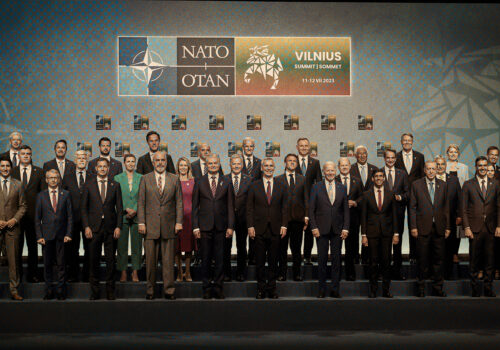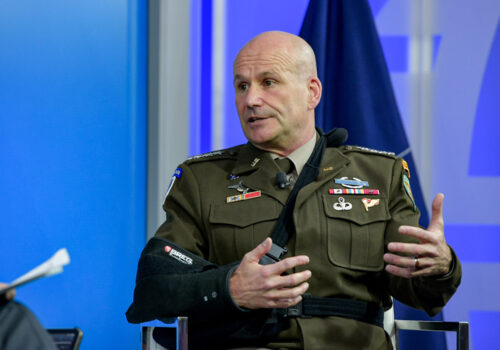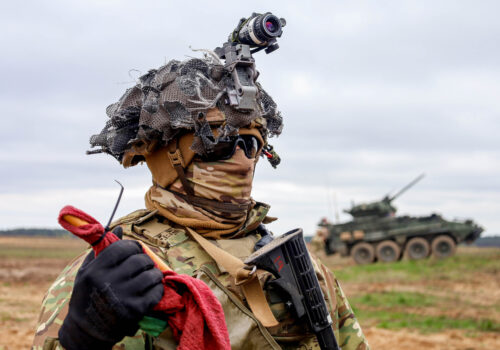National resilience is a crucial part of defense. Here are the countries doing it right.
National resilience has long been part of NATO’s mission; indeed, it has its very own paragraph in the North Atlantic Treaty. But for years, NATO allies neglected national resilience. Recently, however, many of them have realized that national resilience is fundamental to their security. Better yet, some are now taking innovative action to improve their resilience. Learning from the allies that are already taking action will give other allies that decide to enhance their resilience a leg up.
“In order more effectively to achieve the objectives of this Treaty, the Parties, separately and jointly, by means of continuous and effective self-help and mutual aid, will maintain and develop their individual and collective capacity to resist armed attack,” reads Article 3 of the North Atlantic Treaty, which was signed seventy-five years ago in Washington, DC. Even though Article 3 precedes Article 5, many allies have not taken it particularly seriously—at least not since the end of the Cold War.
That’s because national resilience is harder to quantify than military defense. With the latter, the armed forces, policymakers, and even the public can assess how large and effective efforts are. Armed forces have a specific number of active-duty service members, a specific number of reservists, and specific weaponry. But the “individual and collective capacity to resist armed attack” involves a plethora of skills and items that are much harder to identify, let alone measure. There are no rules governing who should participate in resilience, nor is there an official level at which a country (or organization) is considered resilient.
At the 2016 Warsaw summit, NATO leaders attempted to elevate resilience standards by adopting seven “baseline requirements.” These were: assured continuity of government and critical government services, resilient energy supplies, the ability to deal effectively with the uncontrolled movement of people, resilient food and water resources, the ability to deal with mass casualties, resilient civil communications systems, and resilient civil transportation systems. Creating that list was a worthy step, though some allies have treated the baselines more like ambitions than requirements.
Some allies, though, go far beyond the baseline requirements. Indeed, they make national resilience a matter not just of infrastructure and governmental capabilities: instead, they involve the population. Two of the foremost practitioners of societal resilience, Sweden and Finland, have joined the Alliance at just the right time, because they have invaluable knowledge to share.
In the case of Sweden, its society-wide involvement in national security dates back to World War II, when the country had to meet Nazi leader Adolf Hitler’s total war by marshaling all the resources at its disposal: total defense. During the Cold War, Sweden turned these efforts into a system so well-managed that millions (in a country of some eight million at the end of the Cold War) were involved in various parts of national security: as soldiers, as reservists, as members of auxiliary defense organizations, as civilians in crucial professions (from daycare teachers to nuclear engineers), and as ordinary citizens knowing what to do in case of war, because the authorities had regularly kept them informed.
Finland, prevented by the Soviets from operating auxiliary defense organizations, focused instead on preparedness and what it called mental territorial defense: making the Finns steadfast in their support of the country. (Those interested can read more about it in The Defender’s Dilemma.) In recent years, Sweden has once again proven itself as an innovator when it comes to resilience, with initiatives such as the If Crisis or War Comes leaflet, which the Civil Contingencies Agency published six years ago. Especially now that the two friends and neighbors have finally made it into NATO, other allies can pick from their collection of resilience practices and adopt and adapt the ones they like without having to spend the considerable time it takes to create such practices from scratch. Indeed, this kind of learning is already picking up speed. These days Latvia, for example, has a Sweden-like booklet called How to Deal with a Crisis.
But the much-lauded Swedes and Finns, and their Nordic and Baltic friends, are not NATO’s only resilience leaders. The Czech Republic has, through its ministry of defense, launched gray-zone exercises for the private sector. Until the Czech initiative, national-security training for companies had barely been addressed by NATO’s member states, mostly because doing so would require setting up a new format and designing the exercises. Now that the Czech Republic has done so, others can save time and effort by building on the Czechs’ initiatives.
Other allies are also taking important steps. Latvia, for its part, has introduced a defense curriculum that teaches all its high schoolers resilience skills. Germany’s Technisches Hilfswerk (THW), too, is a model worth learning from: 99 percent of those working for this federal agency, whose members help in public emergencies such as storms, are volunteers. The THW doesn’t have a national security mandate, but its model can easily be adapted to national resilience. NATO member states would also do well to learn from close friends outside the Alliance. In the Indo-Pacific, Singapore has an annual total defense day, and Australia is developing an ambitious resilience strategy.
Not every practice is applicable to every NATO country, but what matters is that solutions exist. Learning from friends willing to share best practices is the easiest and most efficient way of learning.
Elisabeth Braw is a senior fellow with the Atlantic Council’s Transatlantic Security Initiative in the Scowcroft Center for Strategy and Security and the author of Goodbye, Globalization: The Return of a Divided World (Yale University Press: 2024).
NATO’s seventy-fifth anniversary is a milestone in a remarkable story of reinvention, adaptation, and unity. However, as the Alliance seeks to secure its future for the next seventy-five years, it faces the revanchism of old rivals, escalating strategic competition, and uncertainties over the future of the rules-based international order.
With partners and allies turning attention from celebrations to challenges, the Atlantic Council’s Transatlantic Security Initiative invited contributors to engage with the most pressing concerns ahead of the historic Washington summit and chart a path for the Alliance’s future. This series will feature seven essays focused on concrete issues that NATO must address at the Washington summit and five essays that examine longer-term challenges the Alliance must confront to ensure transatlantic security.
Further reading
Tue, May 28, 2024
Why NATO matters
New Atlanticist By Richard D. Hooker, Jr.
The United States supports and leads NATO not out of altruism, but because it is manifestly in its interest to do so.
Fri, May 17, 2024
NATO must ‘win up front but be ready to win long’ in modern warfare, says General Christopher Cavoli
New Atlanticist By Katherine Walla
At an Atlantic Council Front Page event, Cavoli spoke about the war in Ukraine, NATO's modernization efforts, the China challenge, and more.
Mon, May 6, 2024
Dispatch from Vilnius: Allies still waiting for the ‘Long Telegram’ from Washington
New Atlanticist By Andrew D’Anieri, Doug Klain
US and European policymakers should learn from the urgency with which frontline nations regard the threat of a Russian invasion.


